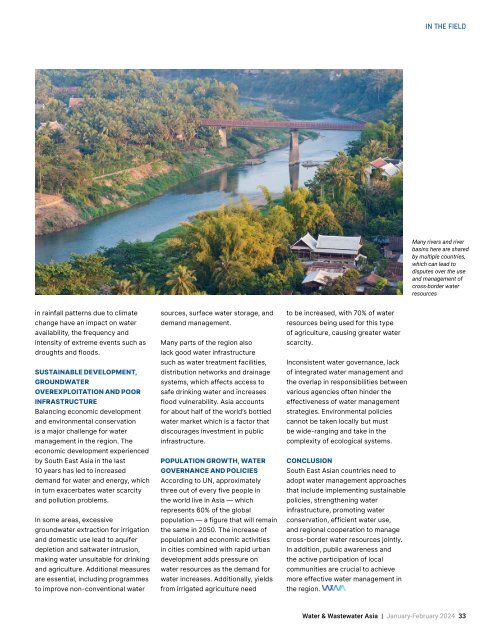Water & Wastewater Asia January/February 2024
Water & Wastewater Asia is an expert source of industry information, cementing its position as an indispensable tool for trade professionals in the water and wastewater industry. As the most reliable publication in the region, industry experts turn this premium journal for credible journalism and exclusive insight provided by fellow industry professionals. Water & Wastewater Asia incorporates the official newsletter of the Singapore Water Association (SWA).
Water & Wastewater Asia is an expert source of industry information, cementing its position as an indispensable tool for trade professionals in the water and wastewater industry. As the most reliable publication in the region, industry experts turn this premium journal for credible journalism and exclusive insight provided by fellow industry professionals. Water & Wastewater Asia incorporates the official newsletter of the Singapore Water Association (SWA).
Create successful ePaper yourself
Turn your PDF publications into a flip-book with our unique Google optimized e-Paper software.
IN THE FIELD<br />
Many rivers and river<br />
basins here are shared<br />
by multiple countries,<br />
which can lead to<br />
disputes over the use<br />
and management of<br />
cross-border water<br />
resources<br />
in rainfall patterns due to climate<br />
change have an impact on water<br />
availability, the frequency and<br />
intensity of extreme events such as<br />
droughts and floods.<br />
SUSTAINABLE DEVELOPMENT,<br />
GROUNDWATER<br />
OVEREXPLOITATION AND POOR<br />
INFRASTRUCTURE<br />
Balancing economic development<br />
and environmental conservation<br />
is a major challenge for water<br />
management in the region. The<br />
economic development experienced<br />
by South East <strong>Asia</strong> in the last<br />
10 years has led to increased<br />
demand for water and energy, which<br />
in turn exacerbates water scarcity<br />
and pollution problems.<br />
In some areas, excessive<br />
groundwater extraction for irrigation<br />
and domestic use lead to aquifer<br />
depletion and saltwater intrusion,<br />
making water unsuitable for drinking<br />
and agriculture. Additional measures<br />
are essential, including programmes<br />
to improve non-conventional water<br />
sources, surface water storage, and<br />
demand management.<br />
Many parts of the region also<br />
lack good water infrastructure<br />
such as water treatment facilities,<br />
distribution networks and drainage<br />
systems, which affects access to<br />
safe drinking water and increases<br />
flood vulnerability. <strong>Asia</strong> accounts<br />
for about half of the world’s bottled<br />
water market which is a factor that<br />
discourages investment in public<br />
infrastructure.<br />
POPULATION GROWTH, WATER<br />
GOVERNANCE AND POLICIES<br />
According to UN, approximately<br />
three out of every five people in<br />
the world live in <strong>Asia</strong> — which<br />
represents 60% of the global<br />
population — a figure that will remain<br />
the same in 2050. The increase of<br />
population and economic activities<br />
in cities combined with rapid urban<br />
development adds pressure on<br />
water resources as the demand for<br />
water increases. Additionally, yields<br />
from irrigated agriculture need<br />
to be increased, with 70% of water<br />
resources being used for this type<br />
of agriculture, causing greater water<br />
scarcity.<br />
Inconsistent water governance, lack<br />
of integrated water management and<br />
the overlap in responsibilities between<br />
various agencies often hinder the<br />
effectiveness of water management<br />
strategies. Environmental policies<br />
cannot be taken locally but must<br />
be wide-ranging and take in the<br />
complexity of ecological systems.<br />
CONCLUSION<br />
South East <strong>Asia</strong>n countries need to<br />
adopt water management approaches<br />
that include implementing sustainable<br />
policies, strengthening water<br />
infrastructure, promoting water<br />
conservation, efficient water use,<br />
and regional cooperation to manage<br />
cross-border water resources jointly.<br />
In addition, public awareness and<br />
the active participation of local<br />
communities are crucial to achieve<br />
more effective water management in<br />
the region.<br />
<strong>Water</strong> & <strong>Wastewater</strong> <strong>Asia</strong> | <strong>January</strong>-<strong>February</strong> <strong>2024</strong> 33

















